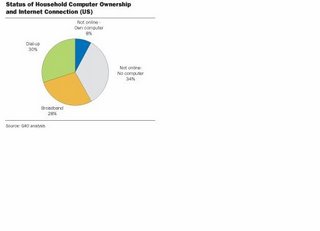
In a historic first, online media companies collectively will sell more ads in local markets this year than such individual hometown media as newspapers, broadcasters and yellow pages, says Borrell Associates. That's a tipping point, a stage of development when critical mass for some new phenomenon is reached.
Five years ago business phone systems hit a tipping point: most new systems were IP-capable. A couple years ago another tipping point was reached and new phone systems mostly are IP-only. These days most new phone sales are for IP systems.
Likewise, Internet usage and access hit similar tipping points earlier this decade. Most people now use the Internet, and that wasn't true 10 years ago. Also, there was a tipping poin when broadband caught and then surpassed dial-up access as the dominant access medium.
Then there was some tipping point reached where access speeds accelerated beyond the "affordable mass access in the hundreds of kilobits per second range" to "affordable mass access in the megabits per second range."
You can see tipping points for text messaging and mobile phone use as well, even though it is only within the last decade that most people started carrying mobile phones and only within the last five years that most younger users began texting heavily, dragging older users along with them.
One watches for tipping points for all sorts of practical reasons, including evidence that it now is time to restructure the way marketing, sales, production, business models, distribution, industrial design, menus and all sorts of very practical things get done.
And the point is that all media are approaching tipping points of their own, and for reasons largely analogous to how communications is changing because of Moore's Law, IP, peer-to-peer, cheap storage, optical fiber, wireless and Web services.
In the newspaper local advertising area, a new tipping point appears to have been reached.
Online-only media companies will have claimed 43.7 percent of the $8.5 billion spent in 2007 on local advertising, usurping the long-time lead of newspapers. While newspapers three years ago controlled 44.1 percent of the local market, they will capture only 33.4 percent of sales this year.
The growth of the online media companies “came mainly at the expense of newspapers and yellow pages publishers,” who have lost a combined 19.6 points of local advertising share in the last three years, says Borrell.
Having spent some time working at newspapers, as well as at publishing companies with multiple products, a concrete way to view tipping points is the impact on structuring of sales forces.
Typically, newspapers and other local media try to build their online businesses by selling new media to their legacy customers. Sometimes they try to use a single sales force to sell online and legacy products. That doesn't work, long term.
In fact, it doesn't quite work even short term, as sales forces direct their behavior to where they can make the most money, and that never is in the emerging businesses.
So one winds up with a strategy akin to launching a Boeing 777 into the air by rolling forward slowly on a long runway. No matter what you do, you crash at the end, because there never is enough runway if you don't get your airspeed up pretty quickly.
Companies that rely on their legacy sales forces to sell the new products--even though it seems logical--will crash their planes at the end of the runway. The only way to succeed is to cut the cord. Build separate sales teams with separate incentive structures; not "converged" sales teams.
One does not "incrementally" jump a very wide ditch. One leaps. One makes it or not. But it can't be done incrementally and slowly.

 With the latest fourth quarter and year-end reports now out from United Online, AOL and EarthLink, the expected trends continue. Dial-up Internet access, like stand-alone long distance before it, throws off cash flow, but less every year. All three leading independent Internet access providers are in the midst of transformation projects, with United Online succeeding most clearly, though it failed to pull off an initial public offering of its Classmates.com unit.
With the latest fourth quarter and year-end reports now out from United Online, AOL and EarthLink, the expected trends continue. Dial-up Internet access, like stand-alone long distance before it, throws off cash flow, but less every year. All three leading independent Internet access providers are in the midst of transformation projects, with United Online succeeding most clearly, though it failed to pull off an initial public offering of its Classmates.com unit.


